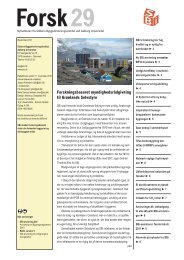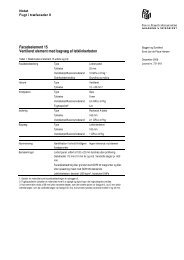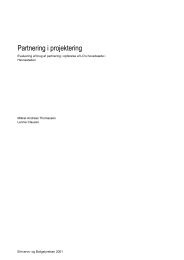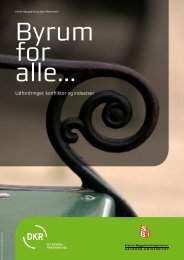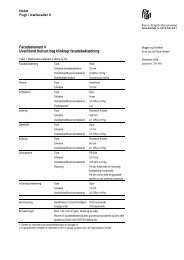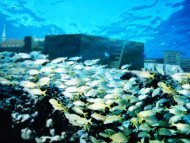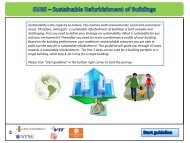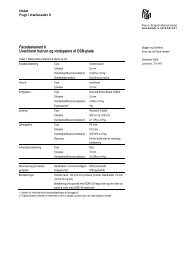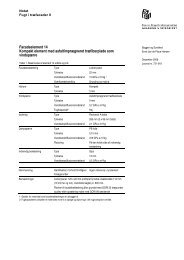Mould growth on building materials - Statens Byggeforskningsinstitut
Mould growth on building materials - Statens Byggeforskningsinstitut
Mould growth on building materials - Statens Byggeforskningsinstitut
Create successful ePaper yourself
Turn your PDF publications into a flip-book with our unique Google optimized e-Paper software.
was seen that the stress of using periods of high and low humidity during a day, trying to<br />
mimic a bathroom. This had a str<strong>on</strong>g selectivity stress towards the phylloplane, Cladosporium,<br />
which under transient c<strong>on</strong>diti<strong>on</strong>s was able to outgrow P. chrysogenum.<br />
The instati<strong>on</strong>ary c<strong>on</strong>diti<strong>on</strong>s, with and without surface c<strong>on</strong>densati<strong>on</strong><br />
(paper 13), can cope with c<strong>on</strong>diti<strong>on</strong>s which keeps the<br />
storage moulds away and still be too dry for the phylloplane. It<br />
can also cope with water accumulati<strong>on</strong> in the surface of <strong>materials</strong>,<br />
especially when working with two to three layer systems,<br />
like a painted piece of cardboard gypsum (3-layer system) 11 .<br />
Hence, the total <str<strong>on</strong>g>growth</str<strong>on</strong>g> behaviour of <strong>materials</strong> is extremely<br />
complicated, and to characterise a material well, the perform-<br />
ance and associated funga under at least three different envir<strong>on</strong>mental<br />
c<strong>on</strong>diti<strong>on</strong>s is needed:<br />
• The lowest RH which supports <str<strong>on</strong>g>growth</str<strong>on</strong>g>.<br />
• The performance under transient c<strong>on</strong>diti<strong>on</strong>s.<br />
• The performance under water damage.<br />
4.2.2 Growth assessment<br />
In paper 10, the <strong>materials</strong> had to be taken out of the set-up for assesment. This was very<br />
time c<strong>on</strong>suming and obscured the envir<strong>on</strong>mental c<strong>on</strong>diti<strong>on</strong>s for the samples. Using the approach<br />
of Adan 11 as in Paper 13 (see Figure 8), the <strong>materials</strong> can be assessed several times<br />
a day if required. The time resoluti<strong>on</strong> of this process describes the susceptibility - as how fast<br />
<str<strong>on</strong>g>growth</str<strong>on</strong>g> started - better than endpoint determinati<strong>on</strong>s of biomass. The latter parameter seems<br />
to describes how much of the substrate could be utilised (papers 10 and 13).<br />
Visual inspecti<strong>on</strong> (paper 13) has a major problem, especially using the 5 point scale described<br />
by British Standard 411 , as the assessed coverage area is the output parameter. This<br />
does not take the c<strong>on</strong>centrati<strong>on</strong> of fungal biomass into account. Thus a material with very<br />
light coverage over all of the material will be assessed to have a higher value than a material<br />
with heavy <str<strong>on</strong>g>growth</str<strong>on</strong>g> over <strong>on</strong>ly a part of the material.<br />
The use of image analysis was partly explored at the stay at TNO Bouw (unpublished), and<br />
this technique will undoubtedly help in future studies, as images for assessing the <strong>materials</strong><br />
can be taken automatically several times a day. It can also cope with the high <str<strong>on</strong>g>growth</str<strong>on</strong>g> rate<br />
observed <strong>on</strong> some paints (where<br />
the <strong>materials</strong> had to be assessed 2-<br />
3 times per day, paper 13). Also a<br />
more standardized assessment including<br />
the fungal "c<strong>on</strong>centrati<strong>on</strong>"<br />
can be made. However this will require<br />
that the image-analysis is calibrated<br />
carefully against very welldescribed<br />
samples. Here chemical<br />
markers could help to compare the<br />
appearance of different moulds.<br />
The use of dissecti<strong>on</strong> microscopy<br />
showed that the moulds often grew<br />
in mixtures (see Figure 10). Looking at <strong>materials</strong> with scarce <str<strong>on</strong>g>growth</str<strong>on</strong>g> and a fibrous surface<br />
was very difficult, and <strong>on</strong>ly sporulati<strong>on</strong> could be detected. However it was possible to distin-<br />
Page 34<br />
Figure 9. The influence of too<br />
high air velocity <strong>on</strong> A. versicolor<br />
<str<strong>on</strong>g>growth</str<strong>on</strong>g> in <strong>on</strong>e side of the set-up.<br />
Figure 10. Mixture of A. flavus, A. versicolor and P. chrysogenum,<br />
growing <strong>on</strong> pinewood.



